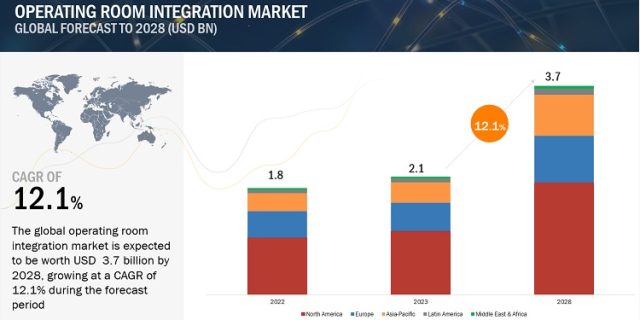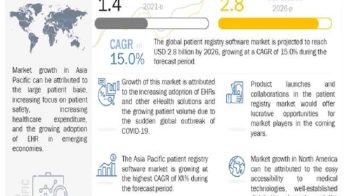
Factors such as growing demand for technologically advanced solutions, rising funding initiatives for improving HCIT infrastructure increase in the number of surgical procedures, , rise on emphasis on cost control and improvement in hospitals operations are aiding to the posticve growth of this market. However, interoperability issues the high setup and operational costs, and shortage of skilled surgeons in OR integration are expected to restrain market growth to a certain extent.
The report Operating Room Integration Market is projected to reach USD 3.7 billion by 2028 from USD 2.1 billion in 2023, at a high CAGR of 12.1% during the forecast period
Download PDF Brochure: –https://www.marketsandmarkets.com/pdfdownloadNew.asp?id=160774667
Operating Room Integration Market Dynamics:
Drivers:
- Rising demand for technologically advanced solutions
- Growing number of surgical procedures worldwide
- Rising funding initiatives for the improvement of HCIT infrastructure
- Increasing emphasis on cost control in hospitals
Opportunities:
- Growth opportunities in emerging economies
Challenges:
- Shortage of skilled surgeons in integrated operating rooms
- Interoperability issues
Benefits of Operating Room Integration:
- Enhanced Collaboration: Operating room integration fosters better communication and collaboration among surgical team members, including surgeons, anesthesiologists, nurses, and specialists.
- Improved Efficiency: By having all necessary information and tools at their fingertips, surgical teams can work more efficiently, reducing procedural time and minimizing disruptions.
- Enhanced Patient Safety: Real-time access to patient data and imaging helps surgical teams make informed decisions quickly, leading to better patient outcomes and safety.
- Training and Education: Operating room integration systems can be used for training purposes, allowing medical students and trainees to observe surgeries without being physically present in the room.
- Data Documentation: Integration systems can automate data recording, providing detailed documentation of surgical procedures for legal and research purposes.
Market Segmentation: –
The software segment accounted for the largest share, by component in the operating room integration market in 2022. The large share of OR integration software is attributed to reduced surgical times, improved patient safety and improved coordination between healthcare providers.
Based on application, the orthopedic surgery segment is expected to register the highest CAGR during the forecast period. Orthopedic surgery aims to attenuate the pain caused by musculoskeletal conditions such as joint arthritis, fractures, torn ligaments, or herniated discs.
Regional Analysis:
North America held the largest share of the operating room integration market in 2022, followed by Europe and Asia Pacific.
- North America:
- North America, particularly the United States, has been a major contributor to the growth of the operating room integration market. The region boasts advanced healthcare infrastructure, a high number of surgeries performed, and a strong focus on adopting innovative medical technologies.
- Europe:
- European countries have also embraced operating room integration solutions to optimize surgical procedures and enhance patient care.
- Countries with robust healthcare systems, such as Germany, France, and the United Kingdom, have shown significant interest in adopting integrated operating room technologies.
- Asia-Pacific:
- The Asia-Pacific region has been experiencing rapid growth in healthcare infrastructure and surgical advancements. Countries like China, Japan, and South Korea are at the forefront of adopting innovative technologies.
- Latin America:
- Latin America has shown a growing interest in healthcare technology adoption, including operating room integration systems.
- Countries like Brazil and Mexico are investing in modernizing healthcare facilities and improving patient care.
- Middle East and Africa:
- The Middle East has been investing in state-of-the-art healthcare infrastructure, including operating room integration solutions.
- High demand for quality healthcare services, medical tourism, and efforts to enhance patient outcomes have led to the adoption of integrated operating room technologies.
Request Sample Pages: –https://www.marketsandmarkets.com/requestsampleNew.asp?id=160774667
Recent Developments
- In February 2023, KARL STORZ collaborated with Asensu Surgical (US), Through this collaboration, the company developed next-generation equipment and also aimed to sell Asensus’ Intelligent Surgical Unit (ISU) as a standalone device.
- In February 2022, Stryker acquired Vocera Communications (US). This acquisition offers Stryker’s Medical division an innovative portfolio that boosts the company’s Advanced Digital Healthcare services and advance Stryker’s focus on preventing adverse occurrences throughout the continuum of care.
- In December 2022, Olympus Corporation (US) collaborated with Sony Corporation (Japan) for the development of a surgical endoscopy system with surgical visualization features such as 4K, 3D, infrared (IR) imaging, and NBI (Narrow Band Imaging).
Top Key Players:
Stryker Corporation (US), STERIS Plc (US), Karl Storz SE & Co. KG (Germany), Olympus Corporation (Japan), and Getinge AB (Sweden) are the major players in this market. These companies are majorly focusing on the strategies such as agreements, collaborations, partnerships, and service launches in order to remain competitive and further increase their share in the market.
The operating room integration market has grown as healthcare facilities seek to enhance surgical capabilities, improve patient care, and stay updated with the latest technologies. However, the extent of adoption can vary based on factors such as healthcare infrastructure, budget constraints, and regulatory environment in different regions. The market continues to evolve with advancements in technology and a focus on patient outcomes.


